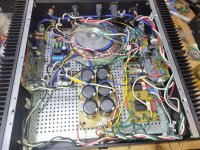I just purchased an old Acurus 200x3 off Ebay. The unit was dropped, and only 1 channel is working. I was going to repair it when it arrives, but I really only bought it for the chassis. My DIY 2 channel amp is a Rod Elliot P101, I really like the sound and power. If I go the route of building 3 more P101's, What size of toroidal transformer would I get away with? I have a 800va 40 +40 in my 2 channel, that I would switch to the 3 channel if that is large enough. I would then get a 500va for the 2 channel ? The units are mainly for my theatre room and play 30% music also.
Attachments
I'm guessing that is a clone? It's modular and quite different from the pictures of an actual Acurus I have seen:

Given that it is a clone, I would say what you do with it really depends upon the quality. If dropped probably pretty easy to repair and judge if you like the sound better than what you want to build. I'm not sure on the transformer thing- so hard to find any specs, unless they are printed on the side. Might check, then you will know what you can do with this one at least. I'm guessing they probably sized it right, looks similar in size if not larger than the original design. Looks like you will get enough good bones to really kick off your new build.
Given that it is a clone, I would say what you do with it really depends upon the quality. If dropped probably pretty easy to repair and judge if you like the sound better than what you want to build. I'm not sure on the transformer thing- so hard to find any specs, unless they are printed on the side. Might check, then you will know what you can do with this one at least. I'm guessing they probably sized it right, looks similar in size if not larger than the original design. Looks like you will get enough good bones to really kick off your new build.
What you bought looks like 2 channel only? I'm not seeing a third amplifier. Still lots of good parts though.
Sorry I had posted my P101, 2 channel. The Acurus arrives next week, hopefully. The rails on the Acurus are 85v from the schematic I received. I believe that would make the transformer in the 3 channel 60 + 60 ?. That would put me at the extreme max for my P101 boards.
Just out of curiosity, Is there much difference in MOSFET verses BIPOLAR ? Sound is speculative, I realize, but would an Acurus of the 90s be considered a well-built and thought of design?
Well, My Acurus 200x3 was lost somewhere in the eBay international hub. I just ordered a Carver av-405 that needs repair, protection light on.
On a positive note, the Carver has 56+- and 42+- rails that will work perfectly with the P101 boards if I can't repair the unit.
On a positive note, the Carver has 56+- and 42+- rails that will work perfectly with the P101 boards if I can't repair the unit.
You ask things...-)
Here's an answer: both Acurus and Carver are multi-stage complementary transes push-pull amplifiers. The P101 has only one complementary transistor push-pull stage, and only two single ended stages. So this one muddles the signal considerably less, which is why it has a much higher sonic potential. However, the P101 is half-wave unsymmetric: Here, bridge the bias circuit with a clean and clear sounding capacitor, > 100 uF,
AC voltage resistance > "+Ve", and remove the bootstrap C 5. Listen to each of these steps, because of "diy audio" 🙂
Remove D3.
No MPSA-types - all I have heared sounded ugly, no audio transes. No 2N types - the same story.
Q7: try BD442. And listen;-)
You could also cut the MosFets, which would help them a little in terms of sound: TO-3Ps are flat and tired players.
And more;-)
Here's an answer: both Acurus and Carver are multi-stage complementary transes push-pull amplifiers. The P101 has only one complementary transistor push-pull stage, and only two single ended stages. So this one muddles the signal considerably less, which is why it has a much higher sonic potential. However, the P101 is half-wave unsymmetric: Here, bridge the bias circuit with a clean and clear sounding capacitor, > 100 uF,
AC voltage resistance > "+Ve", and remove the bootstrap C 5. Listen to each of these steps, because of "diy audio" 🙂
Remove D3.
No MPSA-types - all I have heared sounded ugly, no audio transes. No 2N types - the same story.
Q7: try BD442. And listen;-)
You could also cut the MosFets, which would help them a little in terms of sound: TO-3Ps are flat and tired players.
And more;-)
TO-92 and TO-92L:
Try 2SC types. As example 2SC2240. I have three different ones, > 20 years different too. All in upper midrange, but three different characters;-)
Some BC are very good. But here: buy and listen.
Try 2SC types. As example 2SC2240. I have three different ones, > 20 years different too. All in upper midrange, but three different characters;-)
Some BC are very good. But here: buy and listen.
- Home
- Amplifiers
- Solid State
- Acurus 200x3, repair or gut?
